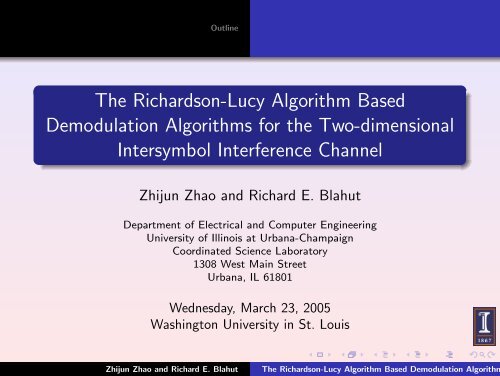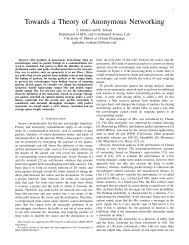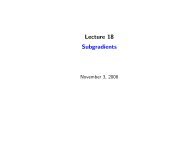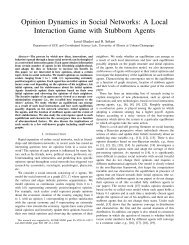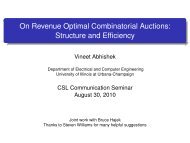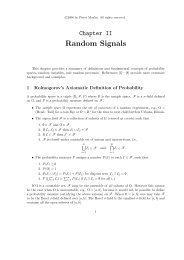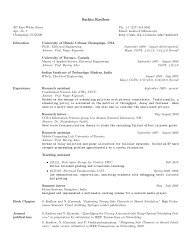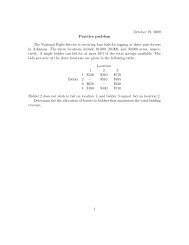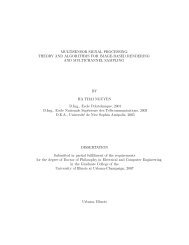The Richardson-Lucy Algorithm Based Demodulation Algorithms for ...
The Richardson-Lucy Algorithm Based Demodulation Algorithms for ...
The Richardson-Lucy Algorithm Based Demodulation Algorithms for ...
Create successful ePaper yourself
Turn your PDF publications into a flip-book with our unique Google optimized e-Paper software.
Outline<br />
<strong>The</strong> <strong>Richardson</strong>-<strong>Lucy</strong> <strong>Algorithm</strong> <strong>Based</strong><br />
<strong>Demodulation</strong> <strong>Algorithm</strong>s <strong>for</strong> the Two-dimensional<br />
Intersymbol Interference Channel<br />
Zhijun Zhao and Richard E. Blahut<br />
Department of Electrical and Computer Engineering<br />
University of Illinois at Urbana-Champaign<br />
Coordinated Science Laboratory<br />
1308 West Main Street<br />
Urbana, IL 61801<br />
Wednesday, March 23, 2005<br />
Washington University in St. Louis<br />
Zhijun Zhao and Richard E. Blahut<br />
<strong>The</strong> <strong>Richardson</strong>-<strong>Lucy</strong> <strong>Algorithm</strong> <strong>Based</strong> <strong>Demodulation</strong> <strong>Algorithm</strong>
Outline<br />
Outline<br />
1 Introduction<br />
2 Two-dimensional ISI Channel Model<br />
3 Wiener <strong>Based</strong> <strong>Demodulation</strong> <strong>Algorithm</strong>s<br />
Wiener <strong>Based</strong> <strong>Demodulation</strong> <strong>Algorithm</strong>s<br />
BER Per<strong>for</strong>mance<br />
4 <strong>Richardson</strong>-<strong>Lucy</strong> <strong>Based</strong> <strong>Demodulation</strong> <strong>Algorithm</strong>s<br />
Blind and Nonblind <strong>Richardson</strong>-<strong>Lucy</strong> <strong>Algorithm</strong>s<br />
<strong>Richardson</strong>-<strong>Lucy</strong> <strong>Algorithm</strong> <strong>for</strong> AWGN Channel<br />
<strong>Richardson</strong>-<strong>Lucy</strong> <strong>Based</strong> <strong>Demodulation</strong> <strong>Algorithm</strong>s<br />
Blind <strong>Demodulation</strong> with Progressive Thresholding<br />
BER Per<strong>for</strong>mance<br />
5 Comparison of Wiener and <strong>Richardson</strong>-<strong>Lucy</strong> <strong>Based</strong> <strong>Algorithm</strong>s<br />
Zhijun Zhao and Richard E. Blahut<br />
<strong>The</strong> <strong>Richardson</strong>-<strong>Lucy</strong> <strong>Algorithm</strong> <strong>Based</strong> <strong>Demodulation</strong> <strong>Algorithm</strong>
Introduction<br />
Two-dimensional ISI Channel Model<br />
Wiener <strong>Based</strong> <strong>Demodulation</strong> <strong>Algorithm</strong>s<br />
<strong>Richardson</strong>-<strong>Lucy</strong> <strong>Based</strong> <strong>Demodulation</strong> <strong>Algorithm</strong>s<br />
Comparison of Wiener and <strong>Richardson</strong>-<strong>Lucy</strong> <strong>Based</strong> <strong>Algorithm</strong>s<br />
Conclusions<br />
Outline<br />
1 Introduction<br />
2 Two-dimensional ISI Channel Model<br />
3 Wiener <strong>Based</strong> <strong>Demodulation</strong> <strong>Algorithm</strong>s<br />
Wiener <strong>Based</strong> <strong>Demodulation</strong> <strong>Algorithm</strong>s<br />
BER Per<strong>for</strong>mance<br />
4 <strong>Richardson</strong>-<strong>Lucy</strong> <strong>Based</strong> <strong>Demodulation</strong> <strong>Algorithm</strong>s<br />
Blind and Nonblind <strong>Richardson</strong>-<strong>Lucy</strong> <strong>Algorithm</strong>s<br />
<strong>Richardson</strong>-<strong>Lucy</strong> <strong>Algorithm</strong> <strong>for</strong> AWGN Channel<br />
<strong>Richardson</strong>-<strong>Lucy</strong> <strong>Based</strong> <strong>Demodulation</strong> <strong>Algorithm</strong>s<br />
Blind <strong>Demodulation</strong> with Progressive Thresholding<br />
BER Per<strong>for</strong>mance<br />
5 Comparison of Wiener and <strong>Richardson</strong>-<strong>Lucy</strong> <strong>Based</strong> <strong>Algorithm</strong>s<br />
Zhijun Zhao and Richard E. Blahut<br />
<strong>The</strong> <strong>Richardson</strong>-<strong>Lucy</strong> <strong>Algorithm</strong> <strong>Based</strong> <strong>Demodulation</strong> <strong>Algorithm</strong>
Introduction<br />
Two-dimensional ISI Channel Model<br />
Wiener <strong>Based</strong> <strong>Demodulation</strong> <strong>Algorithm</strong>s<br />
<strong>Richardson</strong>-<strong>Lucy</strong> <strong>Based</strong> <strong>Demodulation</strong> <strong>Algorithm</strong>s<br />
Comparison of Wiener and <strong>Richardson</strong>-<strong>Lucy</strong> <strong>Based</strong> <strong>Algorithm</strong>s<br />
Conclusions<br />
Two-dimensional Data <strong>Demodulation</strong> Problem<br />
Viterbi algorithm <strong>for</strong> one-dimensional channel<br />
Maximum-likelihood optimal <strong>for</strong> AWGN ISI channel<br />
Good <strong>for</strong> short ISI channel<br />
Computationally expensive <strong>for</strong> long ISI channel<br />
Two-dimensional intersymbol interference channel<br />
Viterbi-like approach: MVA, computationally expensive<br />
Image processing approach<br />
Need an efficient (and optimal) algorithm<br />
Wiener based demodulation algorithms<br />
<strong>Richardson</strong>-<strong>Lucy</strong> based demodulation algorithms<br />
Zhijun Zhao and Richard E. Blahut<br />
<strong>The</strong> <strong>Richardson</strong>-<strong>Lucy</strong> <strong>Algorithm</strong> <strong>Based</strong> <strong>Demodulation</strong> <strong>Algorithm</strong>
Introduction<br />
Two-dimensional ISI Channel Model<br />
Wiener <strong>Based</strong> <strong>Demodulation</strong> <strong>Algorithm</strong>s<br />
<strong>Richardson</strong>-<strong>Lucy</strong> <strong>Based</strong> <strong>Demodulation</strong> <strong>Algorithm</strong>s<br />
Comparison of Wiener and <strong>Richardson</strong>-<strong>Lucy</strong> <strong>Based</strong> <strong>Algorithm</strong>s<br />
Conclusions<br />
Outline<br />
1 Introduction<br />
2 Two-dimensional ISI Channel Model<br />
3 Wiener <strong>Based</strong> <strong>Demodulation</strong> <strong>Algorithm</strong>s<br />
Wiener <strong>Based</strong> <strong>Demodulation</strong> <strong>Algorithm</strong>s<br />
BER Per<strong>for</strong>mance<br />
4 <strong>Richardson</strong>-<strong>Lucy</strong> <strong>Based</strong> <strong>Demodulation</strong> <strong>Algorithm</strong>s<br />
Blind and Nonblind <strong>Richardson</strong>-<strong>Lucy</strong> <strong>Algorithm</strong>s<br />
<strong>Richardson</strong>-<strong>Lucy</strong> <strong>Algorithm</strong> <strong>for</strong> AWGN Channel<br />
<strong>Richardson</strong>-<strong>Lucy</strong> <strong>Based</strong> <strong>Demodulation</strong> <strong>Algorithm</strong>s<br />
Blind <strong>Demodulation</strong> with Progressive Thresholding<br />
BER Per<strong>for</strong>mance<br />
5 Comparison of Wiener and <strong>Richardson</strong>-<strong>Lucy</strong> <strong>Based</strong> <strong>Algorithm</strong>s<br />
Zhijun Zhao and Richard E. Blahut<br />
<strong>The</strong> <strong>Richardson</strong>-<strong>Lucy</strong> <strong>Algorithm</strong> <strong>Based</strong> <strong>Demodulation</strong> <strong>Algorithm</strong>
Introduction<br />
Two-dimensional ISI Channel Model<br />
Wiener <strong>Based</strong> <strong>Demodulation</strong> <strong>Algorithm</strong>s<br />
<strong>Richardson</strong>-<strong>Lucy</strong> <strong>Based</strong> <strong>Demodulation</strong> <strong>Algorithm</strong>s<br />
Comparison of Wiener and <strong>Richardson</strong>-<strong>Lucy</strong> <strong>Based</strong> <strong>Algorithm</strong>s<br />
Conclusions<br />
Two-dimensional ISI channel model<br />
Two-dimensional ISI channel<br />
v(x, y) = h(x, y) ∗ ∗s(x, y) + n(x, y) (1)<br />
where (x, y) ∈ Z 2 .<br />
Fourier domain representation<br />
V (f x , f y ) = H(f x , f y )S(f x , f y ) + N(f x , f y ) (2)<br />
where (f x , f y ) ∈ Z 2 .<br />
Zhijun Zhao and Richard E. Blahut<br />
<strong>The</strong> <strong>Richardson</strong>-<strong>Lucy</strong> <strong>Algorithm</strong> <strong>Based</strong> <strong>Demodulation</strong> <strong>Algorithm</strong>
Introduction<br />
Two-dimensional ISI Channel Model<br />
Wiener <strong>Based</strong> <strong>Demodulation</strong> <strong>Algorithm</strong>s<br />
<strong>Richardson</strong>-<strong>Lucy</strong> <strong>Based</strong> <strong>Demodulation</strong> <strong>Algorithm</strong>s<br />
Comparison of Wiener and <strong>Richardson</strong>-<strong>Lucy</strong> <strong>Based</strong> <strong>Algorithm</strong>s<br />
Conclusions<br />
Simulation Setup<br />
PSF h(x, y)<br />
h(x, y) = C · e −(x2 +y 2 )/2σ 2 h (3)<br />
In simulations, σ h = 0.7,<br />
⎡<br />
0.04390 0.12169<br />
⎤<br />
0.04390<br />
[h] ≈ ⎣ 0.12169 0.33767 0.12169 ⎦ (4)<br />
0.04390 0.12169 0.04390<br />
s(x, y) i.i.d., s(x, y) ∈ {−1/2, 1/2}, or s(x, y) ∈ {0, 1}.<br />
n(x, y) white noise.<br />
Zhijun Zhao and Richard E. Blahut<br />
<strong>The</strong> <strong>Richardson</strong>-<strong>Lucy</strong> <strong>Algorithm</strong> <strong>Based</strong> <strong>Demodulation</strong> <strong>Algorithm</strong>
Introduction<br />
Two-dimensional ISI Channel Model<br />
Wiener <strong>Based</strong> <strong>Demodulation</strong> <strong>Algorithm</strong>s<br />
<strong>Richardson</strong>-<strong>Lucy</strong> <strong>Based</strong> <strong>Demodulation</strong> <strong>Algorithm</strong>s<br />
Comparison of Wiener and <strong>Richardson</strong>-<strong>Lucy</strong> <strong>Based</strong> <strong>Algorithm</strong>s<br />
Conclusions<br />
Original Data Image and Blurred Noisy Image<br />
Zhijun Zhao and Richard E. Blahut<br />
<strong>The</strong> <strong>Richardson</strong>-<strong>Lucy</strong> <strong>Algorithm</strong> <strong>Based</strong> <strong>Demodulation</strong> <strong>Algorithm</strong>
Introduction<br />
Two-dimensional ISI Channel Model<br />
Wiener <strong>Based</strong> <strong>Demodulation</strong> <strong>Algorithm</strong>s<br />
<strong>Richardson</strong>-<strong>Lucy</strong> <strong>Based</strong> <strong>Demodulation</strong> <strong>Algorithm</strong>s<br />
Comparison of Wiener and <strong>Richardson</strong>-<strong>Lucy</strong> <strong>Based</strong> <strong>Algorithm</strong>s<br />
Conclusions<br />
Outline<br />
Wiener <strong>Based</strong> <strong>Demodulation</strong> <strong>Algorithm</strong>s<br />
BER Per<strong>for</strong>mance<br />
1 Introduction<br />
2 Two-dimensional ISI Channel Model<br />
3 Wiener <strong>Based</strong> <strong>Demodulation</strong> <strong>Algorithm</strong>s<br />
Wiener <strong>Based</strong> <strong>Demodulation</strong> <strong>Algorithm</strong>s<br />
BER Per<strong>for</strong>mance<br />
4 <strong>Richardson</strong>-<strong>Lucy</strong> <strong>Based</strong> <strong>Demodulation</strong> <strong>Algorithm</strong>s<br />
Blind and Nonblind <strong>Richardson</strong>-<strong>Lucy</strong> <strong>Algorithm</strong>s<br />
<strong>Richardson</strong>-<strong>Lucy</strong> <strong>Algorithm</strong> <strong>for</strong> AWGN Channel<br />
<strong>Richardson</strong>-<strong>Lucy</strong> <strong>Based</strong> <strong>Demodulation</strong> <strong>Algorithm</strong>s<br />
Blind <strong>Demodulation</strong> with Progressive Thresholding<br />
BER Per<strong>for</strong>mance<br />
5 Comparison of Wiener and <strong>Richardson</strong>-<strong>Lucy</strong> <strong>Based</strong> <strong>Algorithm</strong>s<br />
Zhijun Zhao and Richard E. Blahut<br />
<strong>The</strong> <strong>Richardson</strong>-<strong>Lucy</strong> <strong>Algorithm</strong> <strong>Based</strong> <strong>Demodulation</strong> <strong>Algorithm</strong>
Introduction<br />
Two-dimensional ISI Channel Model<br />
Wiener <strong>Based</strong> <strong>Demodulation</strong> <strong>Algorithm</strong>s<br />
<strong>Richardson</strong>-<strong>Lucy</strong> <strong>Based</strong> <strong>Demodulation</strong> <strong>Algorithm</strong>s<br />
Comparison of Wiener and <strong>Richardson</strong>-<strong>Lucy</strong> <strong>Based</strong> <strong>Algorithm</strong>s<br />
Conclusions<br />
Wiener <strong>Demodulation</strong><br />
Wiener <strong>Based</strong> <strong>Demodulation</strong> <strong>Algorithm</strong>s<br />
BER Per<strong>for</strong>mance<br />
Wiener demodulation algorithm<br />
Wiener estimation of S(f x , f y )<br />
˜S(f x , f y ) = V (f x , f y )G(f x , f y ) (5)<br />
where G(f x , f y ) is the Wiener filter:<br />
G(f x , f y ) =<br />
H ∗ (f x , f y )<br />
H(f x , f y )H ∗ (f x , f y ) + Φ n (f x , f y )/Φ s (f x , f y )<br />
(6)<br />
Hard-thresholding<br />
One-step algorithm<br />
Zhijun Zhao and Richard E. Blahut<br />
<strong>The</strong> <strong>Richardson</strong>-<strong>Lucy</strong> <strong>Algorithm</strong> <strong>Based</strong> <strong>Demodulation</strong> <strong>Algorithm</strong>
Introduction<br />
Two-dimensional ISI Channel Model<br />
Wiener <strong>Based</strong> <strong>Demodulation</strong> <strong>Algorithm</strong>s<br />
<strong>Richardson</strong>-<strong>Lucy</strong> <strong>Based</strong> <strong>Demodulation</strong> <strong>Algorithm</strong>s<br />
Comparison of Wiener and <strong>Richardson</strong>-<strong>Lucy</strong> <strong>Based</strong> <strong>Algorithm</strong>s<br />
Conclusions<br />
Iterative Filtering with Limiting<br />
Wiener <strong>Based</strong> <strong>Demodulation</strong> <strong>Algorithm</strong>s<br />
BER Per<strong>for</strong>mance<br />
Wiener based iterative filtering<br />
S (r+1) (f x , f y ) = S (r) (f x , f y ) + D (r) (f x , f y )G(f x , f y ) (7)<br />
where<br />
D (r) (f x , f y ) = V (f x , f y ) − S (r) (f x , f y )H(f x , f y ) (8)<br />
Limiting regularization<br />
⎧<br />
⎨ 1/2 if s (q) (x, y) ≥ 1/2<br />
s (q) (x, y) ⇐ −1/2 if s<br />
⎩<br />
(x, y) ≤ −1/2<br />
s (q) (x, y) elsewhere<br />
(9)<br />
Hard-thresholding<br />
Zhijun Zhao and Richard E. Blahut<br />
<strong>The</strong> <strong>Richardson</strong>-<strong>Lucy</strong> <strong>Algorithm</strong> <strong>Based</strong> <strong>Demodulation</strong> <strong>Algorithm</strong>
Introduction<br />
Two-dimensional ISI Channel Model<br />
Wiener <strong>Based</strong> <strong>Demodulation</strong> <strong>Algorithm</strong>s<br />
<strong>Richardson</strong>-<strong>Lucy</strong> <strong>Based</strong> <strong>Demodulation</strong> <strong>Algorithm</strong>s<br />
Comparison of Wiener and <strong>Richardson</strong>-<strong>Lucy</strong> <strong>Based</strong> <strong>Algorithm</strong>s<br />
Conclusions<br />
Wiener <strong>Based</strong> <strong>Demodulation</strong> <strong>Algorithm</strong>s<br />
BER Per<strong>for</strong>mance<br />
Iterative Filtering with Progressive Thresholding<br />
Wiener based iterative filtering<br />
Progressive thresholding<br />
⎧<br />
⎨ 1/2 if s (q) (x, y) ≥ T (q)<br />
s (q) (x, y) ⇐ −1/2 if s<br />
⎩<br />
(q) (x, y) < −T (q)<br />
s (q) (x, y) elsewhere<br />
(10)<br />
where T : {0, 1, 2, . . .} → [0, 1/2] is a monotone decreasing<br />
function.<br />
Hard-thresholding<br />
Zhijun Zhao and Richard E. Blahut<br />
<strong>The</strong> <strong>Richardson</strong>-<strong>Lucy</strong> <strong>Algorithm</strong> <strong>Based</strong> <strong>Demodulation</strong> <strong>Algorithm</strong>
Introduction<br />
Two-dimensional ISI Channel Model<br />
Wiener <strong>Based</strong> <strong>Demodulation</strong> <strong>Algorithm</strong>s<br />
<strong>Richardson</strong>-<strong>Lucy</strong> <strong>Based</strong> <strong>Demodulation</strong> <strong>Algorithm</strong>s<br />
Comparison of Wiener and <strong>Richardson</strong>-<strong>Lucy</strong> <strong>Based</strong> <strong>Algorithm</strong>s<br />
Conclusions<br />
BER Per<strong>for</strong>mance Curves<br />
Wiener <strong>Based</strong> <strong>Demodulation</strong> <strong>Algorithm</strong>s<br />
BER Per<strong>for</strong>mance<br />
Zhijun Zhao and Richard E. Blahut<br />
<strong>The</strong> <strong>Richardson</strong>-<strong>Lucy</strong> <strong>Algorithm</strong> <strong>Based</strong> <strong>Demodulation</strong> <strong>Algorithm</strong>
Introduction<br />
Two-dimensional ISI Channel Model<br />
Wiener <strong>Based</strong> <strong>Demodulation</strong> <strong>Algorithm</strong>s<br />
<strong>Richardson</strong>-<strong>Lucy</strong> <strong>Based</strong> <strong>Demodulation</strong> <strong>Algorithm</strong>s<br />
Comparison of Wiener and <strong>Richardson</strong>-<strong>Lucy</strong> <strong>Based</strong> <strong>Algorithm</strong>s<br />
Conclusions<br />
Outline<br />
Blind and Nonblind <strong>Richardson</strong>-<strong>Lucy</strong> <strong>Algorithm</strong>s<br />
<strong>Richardson</strong>-<strong>Lucy</strong> <strong>Algorithm</strong> <strong>for</strong> AWGN Channel<br />
<strong>Richardson</strong>-<strong>Lucy</strong> <strong>Based</strong> <strong>Demodulation</strong> <strong>Algorithm</strong>s<br />
Blind <strong>Demodulation</strong> with Progressive Thresholding<br />
BER Per<strong>for</strong>mance<br />
1 Introduction<br />
2 Two-dimensional ISI Channel Model<br />
3 Wiener <strong>Based</strong> <strong>Demodulation</strong> <strong>Algorithm</strong>s<br />
Wiener <strong>Based</strong> <strong>Demodulation</strong> <strong>Algorithm</strong>s<br />
BER Per<strong>for</strong>mance<br />
4 <strong>Richardson</strong>-<strong>Lucy</strong> <strong>Based</strong> <strong>Demodulation</strong> <strong>Algorithm</strong>s<br />
Blind and Nonblind <strong>Richardson</strong>-<strong>Lucy</strong> <strong>Algorithm</strong>s<br />
<strong>Richardson</strong>-<strong>Lucy</strong> <strong>Algorithm</strong> <strong>for</strong> AWGN Channel<br />
<strong>Richardson</strong>-<strong>Lucy</strong> <strong>Based</strong> <strong>Demodulation</strong> <strong>Algorithm</strong>s<br />
Blind <strong>Demodulation</strong> with Progressive Thresholding<br />
BER Per<strong>for</strong>mance<br />
5 Comparison of Wiener and <strong>Richardson</strong>-<strong>Lucy</strong> <strong>Based</strong> <strong>Algorithm</strong>s<br />
Zhijun Zhao and Richard E. Blahut<br />
<strong>The</strong> <strong>Richardson</strong>-<strong>Lucy</strong> <strong>Algorithm</strong> <strong>Based</strong> <strong>Demodulation</strong> <strong>Algorithm</strong>
Introduction<br />
Two-dimensional ISI Channel Model<br />
Wiener <strong>Based</strong> <strong>Demodulation</strong> <strong>Algorithm</strong>s<br />
<strong>Richardson</strong>-<strong>Lucy</strong> <strong>Based</strong> <strong>Demodulation</strong> <strong>Algorithm</strong>s<br />
Comparison of Wiener and <strong>Richardson</strong>-<strong>Lucy</strong> <strong>Based</strong> <strong>Algorithm</strong>s<br />
Conclusions<br />
Blind and Nonblind <strong>Richardson</strong>-<strong>Lucy</strong> <strong>Algorithm</strong>s<br />
<strong>Richardson</strong>-<strong>Lucy</strong> <strong>Algorithm</strong> <strong>for</strong> AWGN Channel<br />
<strong>Richardson</strong>-<strong>Lucy</strong> <strong>Based</strong> <strong>Demodulation</strong> <strong>Algorithm</strong>s<br />
Blind <strong>Demodulation</strong> with Progressive Thresholding<br />
BER Per<strong>for</strong>mance<br />
<strong>Richardson</strong>-<strong>Lucy</strong> <strong>Algorithm</strong> – Deconvolution of<br />
Nonnegative Images<br />
<strong>The</strong> <strong>Richardson</strong>-<strong>Lucy</strong> <strong>Algorithm</strong><br />
[<br />
]<br />
s (r+1) (x, y) = s (r) v(x, y)<br />
(x, y)<br />
s (r) (x, y) ∗ ∗h(x, y) ∗ ∗h(−x, −y)<br />
Nonnegative everything.<br />
(11)<br />
Zhijun Zhao and Richard E. Blahut<br />
<strong>The</strong> <strong>Richardson</strong>-<strong>Lucy</strong> <strong>Algorithm</strong> <strong>Based</strong> <strong>Demodulation</strong> <strong>Algorithm</strong>
Introduction<br />
Two-dimensional ISI Channel Model<br />
Wiener <strong>Based</strong> <strong>Demodulation</strong> <strong>Algorithm</strong>s<br />
<strong>Richardson</strong>-<strong>Lucy</strong> <strong>Based</strong> <strong>Demodulation</strong> <strong>Algorithm</strong>s<br />
Comparison of Wiener and <strong>Richardson</strong>-<strong>Lucy</strong> <strong>Based</strong> <strong>Algorithm</strong>s<br />
Conclusions<br />
Blind and Nonblind <strong>Richardson</strong>-<strong>Lucy</strong> <strong>Algorithm</strong>s<br />
<strong>Richardson</strong>-<strong>Lucy</strong> <strong>Algorithm</strong> <strong>for</strong> AWGN Channel<br />
<strong>Richardson</strong>-<strong>Lucy</strong> <strong>Based</strong> <strong>Demodulation</strong> <strong>Algorithm</strong>s<br />
Blind <strong>Demodulation</strong> with Progressive Thresholding<br />
BER Per<strong>for</strong>mance<br />
Blind <strong>Richardson</strong>-<strong>Lucy</strong> <strong>Algorithm</strong> – Blind Deconvolution of<br />
Nonnegative Images<br />
Initialize s(x, y) and h(x, y)<br />
Blind <strong>Richardson</strong>-<strong>Lucy</strong> iteration<br />
Estimate h(x, y)<br />
[<br />
]<br />
h (r+1) (x, y) = h(r) (x, y) v(x, y)<br />
∑<br />
(x,y) s(x, y) h (r) (x, y) ∗ ∗s(x, y) ∗ ∗s(−x, −y) (12)<br />
Estimate s(x, y)<br />
[<br />
]<br />
s (r+1) (x, y) = s (r) v(x, y)<br />
(x, y)<br />
s (r) (x, y) ∗ ∗h(x, y) ∗ ∗h(−x, −y)<br />
Nonnegative everything.<br />
(13)<br />
Zhijun Zhao and Richard E. Blahut<br />
<strong>The</strong> <strong>Richardson</strong>-<strong>Lucy</strong> <strong>Algorithm</strong> <strong>Based</strong> <strong>Demodulation</strong> <strong>Algorithm</strong>
Introduction<br />
Two-dimensional ISI Channel Model<br />
Wiener <strong>Based</strong> <strong>Demodulation</strong> <strong>Algorithm</strong>s<br />
<strong>Richardson</strong>-<strong>Lucy</strong> <strong>Based</strong> <strong>Demodulation</strong> <strong>Algorithm</strong>s<br />
Comparison of Wiener and <strong>Richardson</strong>-<strong>Lucy</strong> <strong>Based</strong> <strong>Algorithm</strong>s<br />
Conclusions<br />
Blind and Nonblind <strong>Richardson</strong>-<strong>Lucy</strong> <strong>Algorithm</strong>s<br />
<strong>Richardson</strong>-<strong>Lucy</strong> <strong>Algorithm</strong> <strong>for</strong> AWGN Channel<br />
<strong>Richardson</strong>-<strong>Lucy</strong> <strong>Based</strong> <strong>Demodulation</strong> <strong>Algorithm</strong>s<br />
Blind <strong>Demodulation</strong> with Progressive Thresholding<br />
BER Per<strong>for</strong>mance<br />
<strong>Richardson</strong>-<strong>Lucy</strong> <strong>Algorithm</strong> <strong>for</strong> the AWGN Channel<br />
Limiting and Biasing<br />
n 0 (x, y) ∼ Gauss(0, σ 2 n) (14)<br />
⎧<br />
⎨ 0 if n 0 (x, y) ≤ −ν<br />
n(x, y) = 1 + ν if n 0 (x, y) ≥ ν<br />
⎩<br />
n 0 (x, y) + ν elsewhere<br />
(15)<br />
ñ 0 (x, y) = n(x, y) − ν (16)<br />
In the simulations,<br />
ν = 4σ n (17)<br />
Zhijun Zhao and Richard E. Blahut<br />
<strong>The</strong> <strong>Richardson</strong>-<strong>Lucy</strong> <strong>Algorithm</strong> <strong>Based</strong> <strong>Demodulation</strong> <strong>Algorithm</strong>
Introduction<br />
Two-dimensional ISI Channel Model<br />
Wiener <strong>Based</strong> <strong>Demodulation</strong> <strong>Algorithm</strong>s<br />
<strong>Richardson</strong>-<strong>Lucy</strong> <strong>Based</strong> <strong>Demodulation</strong> <strong>Algorithm</strong>s<br />
Comparison of Wiener and <strong>Richardson</strong>-<strong>Lucy</strong> <strong>Based</strong> <strong>Algorithm</strong>s<br />
Conclusions<br />
Some Concerns<br />
Blind and Nonblind <strong>Richardson</strong>-<strong>Lucy</strong> <strong>Algorithm</strong>s<br />
<strong>Richardson</strong>-<strong>Lucy</strong> <strong>Algorithm</strong> <strong>for</strong> AWGN Channel<br />
<strong>Richardson</strong>-<strong>Lucy</strong> <strong>Based</strong> <strong>Demodulation</strong> <strong>Algorithm</strong>s<br />
Blind <strong>Demodulation</strong> with Progressive Thresholding<br />
BER Per<strong>for</strong>mance<br />
<strong>The</strong> probability of cutting n 0 (x, y)<br />
P r [ñ 0 (x, y) ≠ n 0 (x, y)] = 1 − erf (4/ √ 2) ≈ 3.67 × 10 −6 (18)<br />
Where does ν go?<br />
v(x, y) = h(x, y) ∗ ∗s(x, y) + ñ 0 (x, y) + ν (19)<br />
Answer:<br />
v(x, y) = h(x, y) ∗ ∗ [s(x, y) + ν] + ñ 0 (x, y) (20)<br />
Zhijun Zhao and Richard E. Blahut<br />
<strong>The</strong> <strong>Richardson</strong>-<strong>Lucy</strong> <strong>Algorithm</strong> <strong>Based</strong> <strong>Demodulation</strong> <strong>Algorithm</strong>
Introduction<br />
Two-dimensional ISI Channel Model<br />
Wiener <strong>Based</strong> <strong>Demodulation</strong> <strong>Algorithm</strong>s<br />
<strong>Richardson</strong>-<strong>Lucy</strong> <strong>Based</strong> <strong>Demodulation</strong> <strong>Algorithm</strong>s<br />
Comparison of Wiener and <strong>Richardson</strong>-<strong>Lucy</strong> <strong>Based</strong> <strong>Algorithm</strong>s<br />
Conclusions<br />
<strong>Richardson</strong>-<strong>Lucy</strong> <strong>Algorithm</strong> with Limiting<br />
Blind and Nonblind <strong>Richardson</strong>-<strong>Lucy</strong> <strong>Algorithm</strong>s<br />
<strong>Richardson</strong>-<strong>Lucy</strong> <strong>Algorithm</strong> <strong>for</strong> AWGN Channel<br />
<strong>Richardson</strong>-<strong>Lucy</strong> <strong>Based</strong> <strong>Demodulation</strong> <strong>Algorithm</strong>s<br />
Blind <strong>Demodulation</strong> with Progressive Thresholding<br />
BER Per<strong>for</strong>mance<br />
Estimate s(x, y)<br />
[<br />
]<br />
s (r+1) (x, y) = s (r) v(x, y)<br />
(x, y)<br />
s (r) (x, y) ∗ ∗h(x, y) ∗ ∗h(−x, −y)<br />
Limiting regularization<br />
⎧<br />
⎨ ν + 1<br />
s (q) (x, y) ⇐ ν<br />
⎩<br />
s (q) (x, y)<br />
Hard-thresholding<br />
ŝ(x, y) ⇐<br />
if s (q) (x, y) ≥ 1 + ν<br />
if s (q) (x, y) < ν<br />
elsewhere<br />
{ 1 if s (q) (x, y) ≥ 1/2 + ν<br />
0 if s (q) (x, y) < 1/2 + ν<br />
(21)<br />
(22)<br />
(23)<br />
Zhijun Zhao and Richard E. Blahut<br />
<strong>The</strong> <strong>Richardson</strong>-<strong>Lucy</strong> <strong>Algorithm</strong> <strong>Based</strong> <strong>Demodulation</strong> <strong>Algorithm</strong>
Introduction<br />
Two-dimensional ISI Channel Model<br />
Wiener <strong>Based</strong> <strong>Demodulation</strong> <strong>Algorithm</strong>s<br />
<strong>Richardson</strong>-<strong>Lucy</strong> <strong>Based</strong> <strong>Demodulation</strong> <strong>Algorithm</strong>s<br />
Comparison of Wiener and <strong>Richardson</strong>-<strong>Lucy</strong> <strong>Based</strong> <strong>Algorithm</strong>s<br />
Conclusions<br />
Blind and Nonblind <strong>Richardson</strong>-<strong>Lucy</strong> <strong>Algorithm</strong>s<br />
<strong>Richardson</strong>-<strong>Lucy</strong> <strong>Algorithm</strong> <strong>for</strong> AWGN Channel<br />
<strong>Richardson</strong>-<strong>Lucy</strong> <strong>Based</strong> <strong>Demodulation</strong> <strong>Algorithm</strong>s<br />
Blind <strong>Demodulation</strong> with Progressive Thresholding<br />
BER Per<strong>for</strong>mance<br />
<strong>Richardson</strong>-<strong>Lucy</strong> with Progressive Thresholding<br />
Estimate s(x, y)<br />
[<br />
]<br />
s (r+1) (x, y) = s (r) v(x, y)<br />
(x, y)<br />
s (r) (x, y) ∗ ∗h(x, y) ∗ ∗h(−x, −y)<br />
Progressive thresholding<br />
⎧<br />
⎨ ν + 1<br />
s (q) (x, y) ⇐ ν<br />
⎩<br />
s (q) (x, y)<br />
if s (q) (x, y) ≥ 1/2 + ν + T (q)<br />
if s (q) (x, y) ≤ 1/2 + ν − T (q)<br />
elsewhere<br />
where q = r + 1, T : {0, 1, 2, . . .} → [0, 1/2] is a monotone<br />
decreasing function of iteration.<br />
Hard-thresholding<br />
(24)<br />
(25)<br />
Zhijun Zhao and Richard E. Blahut<br />
<strong>The</strong> <strong>Richardson</strong>-<strong>Lucy</strong> <strong>Algorithm</strong> <strong>Based</strong> <strong>Demodulation</strong> <strong>Algorithm</strong>
Introduction<br />
Two-dimensional ISI Channel Model<br />
Wiener <strong>Based</strong> <strong>Demodulation</strong> <strong>Algorithm</strong>s<br />
<strong>Richardson</strong>-<strong>Lucy</strong> <strong>Based</strong> <strong>Demodulation</strong> <strong>Algorithm</strong>s<br />
Comparison of Wiener and <strong>Richardson</strong>-<strong>Lucy</strong> <strong>Based</strong> <strong>Algorithm</strong>s<br />
Conclusions<br />
Blind and Nonblind <strong>Richardson</strong>-<strong>Lucy</strong> <strong>Algorithm</strong>s<br />
<strong>Richardson</strong>-<strong>Lucy</strong> <strong>Algorithm</strong> <strong>for</strong> AWGN Channel<br />
<strong>Richardson</strong>-<strong>Lucy</strong> <strong>Based</strong> <strong>Demodulation</strong> <strong>Algorithm</strong>s<br />
Blind <strong>Demodulation</strong> with Progressive Thresholding<br />
BER Per<strong>for</strong>mance<br />
Blind <strong>Richardson</strong>-<strong>Lucy</strong> with Progressive Thresholding<br />
Initialize s(x, y) and h(x, y)<br />
Estimate h(x, y) and s(x, y) alternatively<br />
[<br />
]<br />
h (r+1) (x, y) = h(r) (x, y) v(x, y)<br />
∑<br />
(x,y) s(x, y) h (r) (x, y) ∗ ∗s(x, y) ∗ ∗s(−x, −y)<br />
(26)<br />
[<br />
]<br />
s (r+1) (x, y) = s (r) v(x, y)<br />
(x, y)<br />
s (r) (x, y) ∗ ∗h(x, y) ∗ ∗h(−x, −y)<br />
Progressive thresholding<br />
⎧<br />
⎨ ν + 1<br />
s (q) (x, y) ⇐ ν<br />
⎩<br />
s (q) (x, y)<br />
Hard-thresholding<br />
Zhijun Zhao and Richard E. Blahut<br />
if s (q) (x, y) ≥ 1/2 + ν + T (q)<br />
if s (q) (x, y) ≤ 1/2 + ν − T (q)<br />
elsewhere<br />
(27)<br />
(28)<br />
<strong>The</strong> <strong>Richardson</strong>-<strong>Lucy</strong> <strong>Algorithm</strong> <strong>Based</strong> <strong>Demodulation</strong> <strong>Algorithm</strong>
Introduction<br />
Two-dimensional ISI Channel Model<br />
Wiener <strong>Based</strong> <strong>Demodulation</strong> <strong>Algorithm</strong>s<br />
<strong>Richardson</strong>-<strong>Lucy</strong> <strong>Based</strong> <strong>Demodulation</strong> <strong>Algorithm</strong>s<br />
Comparison of Wiener and <strong>Richardson</strong>-<strong>Lucy</strong> <strong>Based</strong> <strong>Algorithm</strong>s<br />
Conclusions<br />
Blind and Nonblind <strong>Richardson</strong>-<strong>Lucy</strong> <strong>Algorithm</strong>s<br />
<strong>Richardson</strong>-<strong>Lucy</strong> <strong>Algorithm</strong> <strong>for</strong> AWGN Channel<br />
<strong>Richardson</strong>-<strong>Lucy</strong> <strong>Based</strong> <strong>Demodulation</strong> <strong>Algorithm</strong>s<br />
Blind <strong>Demodulation</strong> with Progressive Thresholding<br />
BER Per<strong>for</strong>mance<br />
BER Curves of the <strong>Richardson</strong>-<strong>Lucy</strong> <strong>Based</strong> <strong>Algorithm</strong>s<br />
Zhijun Zhao and Richard E. Blahut<br />
<strong>The</strong> <strong>Richardson</strong>-<strong>Lucy</strong> <strong>Algorithm</strong> <strong>Based</strong> <strong>Demodulation</strong> <strong>Algorithm</strong>
Introduction<br />
Two-dimensional ISI Channel Model<br />
Wiener <strong>Based</strong> <strong>Demodulation</strong> <strong>Algorithm</strong>s<br />
<strong>Richardson</strong>-<strong>Lucy</strong> <strong>Based</strong> <strong>Demodulation</strong> <strong>Algorithm</strong>s<br />
Comparison of Wiener and <strong>Richardson</strong>-<strong>Lucy</strong> <strong>Based</strong> <strong>Algorithm</strong>s<br />
Conclusions<br />
Outline<br />
1 Introduction<br />
2 Two-dimensional ISI Channel Model<br />
3 Wiener <strong>Based</strong> <strong>Demodulation</strong> <strong>Algorithm</strong>s<br />
Wiener <strong>Based</strong> <strong>Demodulation</strong> <strong>Algorithm</strong>s<br />
BER Per<strong>for</strong>mance<br />
4 <strong>Richardson</strong>-<strong>Lucy</strong> <strong>Based</strong> <strong>Demodulation</strong> <strong>Algorithm</strong>s<br />
Blind and Nonblind <strong>Richardson</strong>-<strong>Lucy</strong> <strong>Algorithm</strong>s<br />
<strong>Richardson</strong>-<strong>Lucy</strong> <strong>Algorithm</strong> <strong>for</strong> AWGN Channel<br />
<strong>Richardson</strong>-<strong>Lucy</strong> <strong>Based</strong> <strong>Demodulation</strong> <strong>Algorithm</strong>s<br />
Blind <strong>Demodulation</strong> with Progressive Thresholding<br />
BER Per<strong>for</strong>mance<br />
5 Comparison of Wiener and <strong>Richardson</strong>-<strong>Lucy</strong> <strong>Based</strong> <strong>Algorithm</strong>s<br />
Zhijun Zhao and Richard E. Blahut<br />
<strong>The</strong> <strong>Richardson</strong>-<strong>Lucy</strong> <strong>Algorithm</strong> <strong>Based</strong> <strong>Demodulation</strong> <strong>Algorithm</strong>
Introduction<br />
Two-dimensional ISI Channel Model<br />
Wiener <strong>Based</strong> <strong>Demodulation</strong> <strong>Algorithm</strong>s<br />
<strong>Richardson</strong>-<strong>Lucy</strong> <strong>Based</strong> <strong>Demodulation</strong> <strong>Algorithm</strong>s<br />
Comparison of Wiener and <strong>Richardson</strong>-<strong>Lucy</strong> <strong>Based</strong> <strong>Algorithm</strong>s<br />
Conclusions<br />
Comparison of Wiener and <strong>Richardson</strong>-<strong>Lucy</strong> <strong>Based</strong><br />
<strong>Demodulation</strong> <strong>Algorithm</strong>s<br />
Zhijun Zhao and Richard E. Blahut<br />
<strong>The</strong> <strong>Richardson</strong>-<strong>Lucy</strong> <strong>Algorithm</strong> <strong>Based</strong> <strong>Demodulation</strong> <strong>Algorithm</strong>
Introduction<br />
Two-dimensional ISI Channel Model<br />
Wiener <strong>Based</strong> <strong>Demodulation</strong> <strong>Algorithm</strong>s<br />
<strong>Richardson</strong>-<strong>Lucy</strong> <strong>Based</strong> <strong>Demodulation</strong> <strong>Algorithm</strong>s<br />
Comparison of Wiener and <strong>Richardson</strong>-<strong>Lucy</strong> <strong>Based</strong> <strong>Algorithm</strong>s<br />
Conclusions<br />
Conclusions<br />
Conclusions<br />
<strong>The</strong> progressive thresholding applies the binary constraint, and<br />
gives significant BER improvement.<br />
<strong>The</strong> <strong>Richardson</strong>-<strong>Lucy</strong> based blind demodulation algorithm with<br />
progressive thresholding achieves near nonblind per<strong>for</strong>mance.<br />
<strong>Richardson</strong>-<strong>Lucy</strong> based algorithms outper<strong>for</strong>m the Wiener<br />
based algorithms.<br />
Ongoing and Future Work<br />
<strong>The</strong> optimality and convergence of the <strong>Richardson</strong>-<strong>Lucy</strong> based<br />
demodulation algorithms.<br />
Zhijun Zhao and Richard E. Blahut<br />
<strong>The</strong> <strong>Richardson</strong>-<strong>Lucy</strong> <strong>Algorithm</strong> <strong>Based</strong> <strong>Demodulation</strong> <strong>Algorithm</strong>


